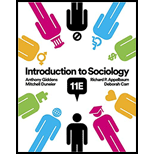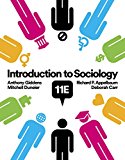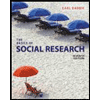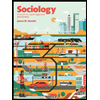
Introduction
Six characteristics that everyone faces at work include: 1. Money - wages or salary; 2. Activity level - structured environment; 3. Variety - work is different from chores at home; 4. Structuring one's time - people organize their lives around work; 5. Social contact - many friends are made at work; and 6. Personal identity - many people's work define them.
Explanation of Solution
Answer and explanation
Everyone's work experience is shaped by these six factors: 1. Money - they payment for a person's labor eases stress over making a living and allows them to pay bills and provide for their own and their families necessities; 2. Activity level - work often provides the motivation for gaining new skills and an environment in which to use them; 3. Variety - work provides a contrast to the context of the home by using different skills than chores, helping one to create a mental distinction between their home- and work lives; 4. Structuring one's time - work provides a way to organize one's life and prevents boredom; 5. Social contact - work provides opportunities to engage in activities with others and build friendships; 6. Personal identity - occupations provide stable social identity. For example a person might mention they are a teacher as part of introducing themselves.
Want to see more full solutions like this?
Chapter 14 Solutions
EBK INTRODUCTION TO SOCIOLOGY (ELEVENTH
- video "SDG's aren't the same old, same old." What are SDG's? Sustainable Development Goals or "Global Goals" created by the United Nations (UN) https://www.youtube.com/watch?v=v7WUpgPZzpI&t=4s Describe at least 3 of the Global Goals mentioned in the video.arrow_forwardWatch the following video about early intervention for children with visual impairments: (its 10 minutes long) http://www.youtube.com/watch?v=6rbHOAtBNew After watching the video, consider the following: How were parents and family members involved in the early interventions offered to their child? Why was this involvement important? What sort of interventions were used? How were these beneficial?arrow_forwardSimple/ humanized answers: How has the field of education for students with visual impairments (low vision and blindness) evolved? What is the definition of “visual impairment,” how are students identified, and what are the typical causes of visual impairments? Why is early intervention so critical for children with visual impairments, and how can families support children with visual impairments? What are some specific concerns for culturally and/or linguistically diverse children with visual impairments? What kinds of educational responses are needed to address the needs of students with visual impairments?arrow_forward
- How do minor parties influence the U.S. electoral system?arrow_forwardeelancer X English task 1.pdf - Google Driv X kq_A8Yyhcg5Muq83vtY5jmlvjd6ITE/view + Open with Google Docs Task Requirements: Word Count: 300-400 Formatting Style: MLA (for more information click here) *** A minimum of 1 reliable source must be used! Any sources must be properly cited according to the formatting style assigned Many people disagree about the appropriate age to allow children and young adults to use social media. Write an essay that argues your viewpoint about the issue. Develop your claim with reasons and evidence, and form a rebuttal to argue against a counterclaim. Page 1 / 1 Q + 26°C Mcarrow_forwardDCS cans certification exam answers micaharrow_forward
- Describe a business that has used backcasting or scenarios to assess a situation and then developed a strategy to achieve their goals? what are the obstacles they faced ?arrow_forwardWhy could Backcasting be considered the most useful futuring method? how does the use of modules and simulations relate to futuring? is this method effective?arrow_forward"Literature is able to challenge perceptions by capturing the voices of frequently silenced characters". In the light of this comment show how Alexander Masters is successful in promoting Stuart's voice in Stuart: Alfie backwards. Include any quotes which are relevant.arrow_forward
 Social Psychology (10th Edition)SociologyISBN:9780134641287Author:Elliot Aronson, Timothy D. Wilson, Robin M. Akert, Samuel R. SommersPublisher:Pearson College Div
Social Psychology (10th Edition)SociologyISBN:9780134641287Author:Elliot Aronson, Timothy D. Wilson, Robin M. Akert, Samuel R. SommersPublisher:Pearson College Div Introduction to Sociology (Eleventh Edition)SociologyISBN:9780393639407Author:Deborah Carr, Anthony Giddens, Mitchell Duneier, Richard P. AppelbaumPublisher:W. W. Norton & Company
Introduction to Sociology (Eleventh Edition)SociologyISBN:9780393639407Author:Deborah Carr, Anthony Giddens, Mitchell Duneier, Richard P. AppelbaumPublisher:W. W. Norton & Company The Basics of Social Research (MindTap Course Lis...SociologyISBN:9781305503076Author:Earl R. BabbiePublisher:Cengage Learning
The Basics of Social Research (MindTap Course Lis...SociologyISBN:9781305503076Author:Earl R. BabbiePublisher:Cengage Learning Criminalistics: An Introduction to Forensic Scien...SociologyISBN:9780134477596Author:Saferstein, RichardPublisher:PEARSON
Criminalistics: An Introduction to Forensic Scien...SociologyISBN:9780134477596Author:Saferstein, RichardPublisher:PEARSON Sociology: A Down-to-Earth Approach (13th Edition)SociologyISBN:9780134205571Author:James M. HenslinPublisher:PEARSON
Sociology: A Down-to-Earth Approach (13th Edition)SociologyISBN:9780134205571Author:James M. HenslinPublisher:PEARSON Society: The Basics (14th Edition)SociologyISBN:9780134206325Author:John J. MacionisPublisher:PEARSON
Society: The Basics (14th Edition)SociologyISBN:9780134206325Author:John J. MacionisPublisher:PEARSON





